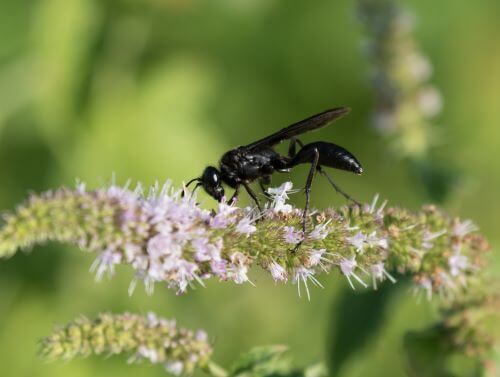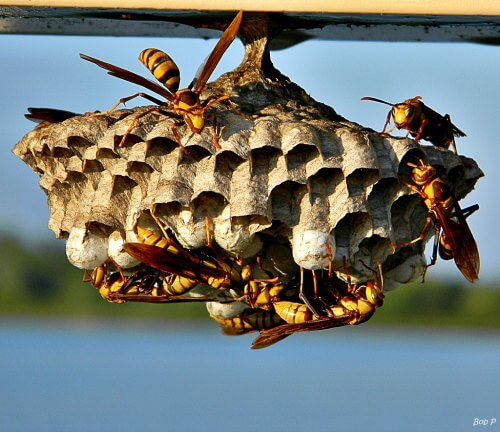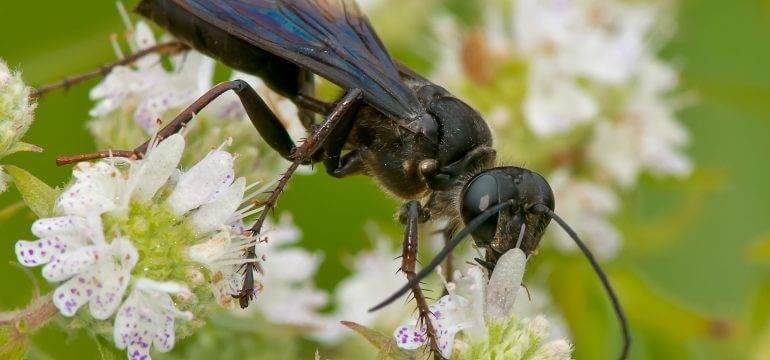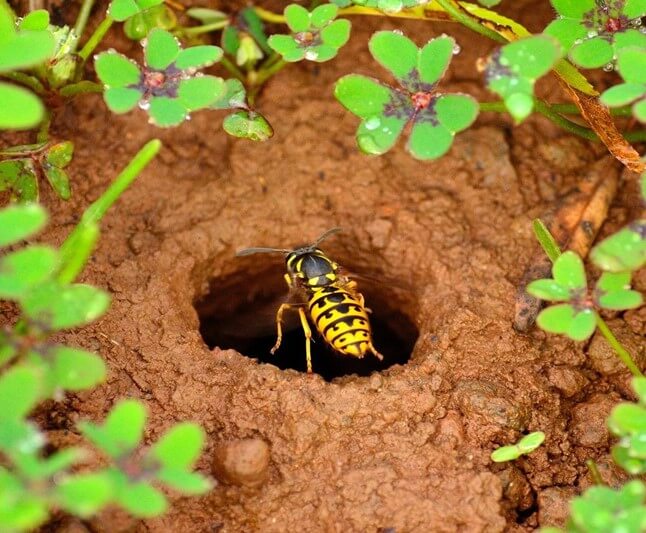Living near a nest of wasps or beehives is a total nightmare, and it is only natural that you want to remove it as soon as possible.
So, if your house is threatened by black wasps (although the points we will discuss will work for other bugs and insects), you should put all your work aside and check out this article.
From helping you identify them to killing and getting rid of them, we will discuss everything you need about black wasps and getting rid of them in Oregon (or any other place) for a protected and happy home.
Step-By-Step Guide to Kill and Remove Black Wasps

Managing the presence of black wasps around your home requires careful planning and execution to ensure safety for both you and the wasps.
This guide focuses on humane and non-lethal methods to deter black wasps, minimizing the need to kill them and acknowledging their role in the ecosystem.
Here’s a step-by-step approach:
Step 1: Identification and Observation
- Identify the Wasps: Ensure that the insects are indeed black wasps. Black wasps are typically larger than other wasps and have distinct long legs that dangle during flight.
- Observe the Activity: Monitor the wasps’ activity from a safe distance to determine the nest’s location and when the wasps are less active.
Step 2: Personal Safety Measures
- Protective Clothing: Wear long sleeves, pants, gloves, and a hat to minimize exposed skin. While black wasps are less aggressive, they may sting if threatened.
- Plan an Escape Route: Before approaching the nest area, plan a clear and quick escape route in case the wasps become agitated.
Step 3: Non-Lethal Deterrents
- Wasp Decoys: Install wasp decoys around your property to exploit their territorial nature, preventing them from building new nests.
- Natural Repellents: To discourage wasps, use natural repellents such as essential oils (peppermint, citronella) around the nest area and outdoor living spaces.
Step 4: Environmental Management
- Remove Attractants: Ensure garbage bins are sealed, and no food scraps or sweet liquids are left outside.
- Garden Maintenance: Regularly trim vegetation and remove dead plants to reduce nesting sites.
Step 5: Nest Management
- Non-Invasive Techniques: If the nest is not in a high-traffic area, consider leaving it alone, especially if it poses no direct threat. Wasps can benefit gardens by controlling pest populations.
- Relocation: For nests that must be moved, consider contacting a professional who can safely relocate the nest without killing the wasps.
Step 6: Long-Term Prevention
- Seal Entry Points: Check your home for cracks and gaps where wasps could enter and build nests. Seal these points with caulk or mesh.
- Landscaping Choices: Incorporate wasp-repelling plants, such as mint, basil, and marigold, into your garden.
Step 7: Professional Assistance
- Consult Experts: If the wasp presence is overwhelming or you are unsure how to proceed safely, seek assistance from pest control professionals who practice humane removal methods.
Step 8: Monitoring and Maintenance
- Regular Checks: Periodically inspect your property for signs of new wasp activity, especially during the warmer months.
- Community Awareness: Share your approach with neighbors, as coordinated efforts can more effectively manage wasp populations in a neighborhood.
What Should You Do to Remove Wasps Outdoor?

1. Wear a Protective Suit
This is the most important step of all. Safety in removing the nest of black wasps is essential.
Wear a protective suit before you start on the mission. You can buy one online with a safety hood and an overall bodysuit or wear full-sleeved clothes.
Bee suits are made of thick cotton so the bees cannot penetrate the material.
The only drawback is that the thick cotton is unbreathable, and it can get difficult for you to work wearing that in summer.
The other option (in case you do not want to invest in bee suits) is to wear jeans, a full-sleeved shirt with a jacket, sunglasses, and a cap.
Ensure you have the least amount of skin exposed so that even if the wasps attack you, you are not hurt that much.
2. Buy an Insecticide
The next thing that you need is a wasp insecticide.
Before completely diving into the nest full of wasps, it is better to spray some insecticide that can kill a lot of wasps (almost all outside and a few inside the nest as well).
This will ensure fewer wasps to fight when you are near the nest.
Also, make sure you buy an insecticide that you can spray from a distance of at least 20 meters to attack the best black wasps without going too close to the nest.
This is another safety hack that you should not take lightly because if you are not an expert, fighting an entire gang of wasps will be very difficult for you, and you might also end up hurting yourself.
3. Ultimately Approaching the Nest
Now that you have taken the safety precautions and killed the first few wasps outside the nest, it is time to attack the nest.
Now, when you are approaching the nest, it is better to do so at night and preferably at a cooler temperature so that the wasps sleep peacefully.
Once you reach the nest, fill up the opening with the insecticide so that they all die inside in sleep.
Also, ensure that you run immediately after spraying the insecticide because many of the wasps may be disturbed by the attack and fly out and attack you.
In this case, you might end up getting injured badly.
4. Take the Help of a Professional
When not sure what to do, it is always good to take expert advice.
You can contact the local municipality or a local gardener who has dealt with similar cases and ask them what you should do.
If you are allergic to bee stings, it will be even better to let that person do the work while you ensure you are well-protected and away from the nest.
Alternative, Non-Lethal Methods for Wasp Management

Managing wasp populations around your home don’t always require extreme measures.
Several non-lethal strategies can effectively deter wasps, ensuring both your safety and their survival.
These methods respect the ecological role of wasps in controlling pest populations and pollinating plants.
Here’s how you can manage wasps without resorting to killing them:
1. Wasp Decoys
Wasps are territorial creatures and less likely to build a nest near another colony.
Hanging fake wasp nests around your property can be an effective deterrent.
These decoys can be purchased or homemade and should be placed in early spring when queens search for nesting sites.
2. Natural Repellents
Certain natural substances are known to repel wasps.
Essential oils like peppermint, eucalyptus, and citronella can be mixed with water and sprayed around outdoor living areas and potential nest sites.
Wasps dislike the strong scent of these oils and are likely to stay away.
3. Maintain Your Garden
Regular garden maintenance can deter wasps. Keep bushes and trees trimmed, and remove dead vegetation where wasps might nest.
Ensure all garbage and compost bins are tightly sealed so as not to attract wasps with food odors.
4. Secure Food and Drinks Outdoors
When eating outside, keep food covered and use lidded cups for drinks, especially sugary beverages, which attract wasps.
Clean up promptly after outdoor meals to avoid leaving residues that could lure wasps.
5. Water Traps
If wasps are a persistent problem, consider setting up non-lethal water traps.
Fill a container with water and a small amount of dish soap (which breaks the surface tension of the water), and add a lure like sugar water or a piece of fruit.
The wasps will be attracted to the sweet scent, fall into the water, and be unable to escape.
Regularly check and empty these traps, releasing trapped wasps away from your property.
6. Plant Wasp-repelling Plants
Certain plants are known to repel wasps naturally due to their strong scents.
Planting mint, basil, and marigolds around your garden and outdoor living areas can help keep wasps at bay.
7. Patch Up Cracks and Crevices
Wasps look for sheltered spots to build their nests. Regularly inspect your home’s exterior for cracks, crevices, and holes, especially in eaves, siding, and around windows and doors.
Seal these potential entry points to prevent wasps from setting up a home.
8. Professional Consultation
For persistent wasp problems or if you’re unsure how to proceed, consulting with a pest management professional can provide tailored solutions.
Professionals can offer non-lethal management strategies specific to your situation and local ecosystem.
By adopting these non-lethal methods, you can manage wasp populations effectively while minimizing harm to the wasps and the environment.
These strategies foster a balanced coexistence with wasps, recognizing their role in the ecosystem and reducing the need for lethal control measures.
Things to Avoid Doing While Taking Down a Wasp Nest

1. Burning the Nest
Although it is a popular belief to use fire to get rid of wasps or beehives, it is a very wrong technique.
Wasp nests comprise a wood pulp-like substance that is thin, papery and is, hence, more inflammable.
This can cause the fire to spread out of control and to you and your property.
The second thing that can happen is when burning the nest, the fire does not kill the wasp.
Instead, it can become way more violent and attack you in defense and search of food.
Causing them to lose their home without killing them will make them target you and hurt you or someone passing by your place.
2. Using Water to Remove the Nest
Another popular technique people believe works in removing wasps and their nest is throwing water at them.
Flooding a wasp nest is not a good idea and will not solve your problem.
Also, let us say that the wasp nest is built inside your house then flooding the nest will flood your property and might damage the floor and walls,
Also, like burning a wasp nest, throwing water on it will have the same effect.
The attack will turn the wasps way more violent (and they will certainly not be dead), and out of their rage, they will attack you and leave you with burning wasp stings.
So, you need to cross out this option from your list.
3. Using a Baseball Bat to Bring Down the Nest
Remember, when you are trying to bring down the wasp nest, you aim to kill and get rid of all the wasps, not just remove the nest.
After all, removing the nest without removing the wasps immediately is useless. So again, using a baseball bat is of no use.
The baseball bat will bring down the nest but disturb the resting black wasps, and they will become aggressive and violent.
They will again turn around to attack you. In this technique, you will be standing close to the nest, increasing your chances of getting attacked by the black wasps.
Also, if you are allergic to wasp stings, you can go into anaphylactic shock from the attack.
Hence, this, too, is a very bad idea for getting rid of black wasp nests.
How to Prevent Black Wasps from Building Nests on Your Property

1. Regular Maintenance
The first and most important thing is regular maintenance and cleaning.
Wasps cannot build a nest in a place that is regularly cleaned or even attended to.
If you leave a room (especially the attic or basement) unclean and unattended for a long period, then there are chances that wasps can build a nest in that place.
Also, if you do not take care of the trees in your garden regularly, trim them, water them, and inspect them, then there are chances that wasps can also build a nest in your trees.
2. Installing a Fake Wasp Nest
Wasps are highly territorial, so if they have already seen a wasp nest at a place, then there is a high chance that they will not build one at that place or anywhere near it.
So, if you want an easy solution to prevent wasps from making nests on your property, then install a fake one that will keep them away.
3. Place Fly Traps or Sealed Windows in Your Property
If you think there are chances of wasps making a nest in your house, you can also use fly traps or ensure that your windows are completely sealed when closed.
This will stop the black wasps from entering your house, let alone building a nest in it.
4. Using a DIY Trap
Many DIY traps are easily available in the local gardening centers. You can easily trap the wasps in them and get rid of them.
The reason for doing this is that sometimes the insecticides are very toxic and threaten your family’s health, so using a toxic-free option is way better.
You can also make one at home if you do not want to buy one. All you need is a half-cut plastic bottle and some food to attract them.
You can easily find a DIY recipe for a wasp trap online.
Benefits of Having Black Wasps in Your Garden

Unless you are a gardener, we understand why you want to remove black wasps from your property.
Still, if you are a gardener or a gardening enthusiast, you might be surprised to know that these wasps benefit your garden.
They feed upon insects like grasshoppers and locusts, which are deadly for your green plants and can ruin your garden in the blink of an eye.
So, unless you are attacking them, they will not only not bother you but also protect your garden.
Final Words
So, this was all that you needed to know about removing black wasps and their nest from your property in Oregon (or any other place).
Make sure that you care about your safety, no matter what you do or what technique you adopt to get your work done.
Be all covered up, and do not go too close to the nest when trying to remove it.
We hope that this article was helpful to you and all your doubts were cleared. If you have any more queries, feel free to contact us in the comment section below.

